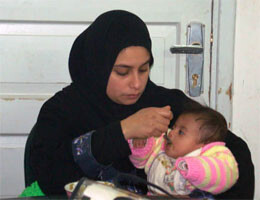Palestinian Center for Human Rights 15 February 2008

Ard al-Insan Child Nutrition Center in Gaza city treated almost 8,500 malnourished youngsters last year. (PCHR)
Najah Zohod is the Nutritional Director of the Ard al-Insan Child Nutrition Center in Gaza City. The center works exclusively with malnourished under-five-year-olds. Children are regularly referred to Ard al-Insan from the Gaza-based UN Relief and Works Agency (UNRWA) which supports some of the poorest communities in the Gaza Strip. But many mothers self-refer, by simply turning up at the center with their babies and young children. This morning Ard al-Insan is crowded with women and children queuing for assessments and treatment. Most of the children are quiet, and some look thin and listless.
“Our target group is children suffering second and third degree malnutrition” says Najah Zohod. “We weigh every child who comes here, and take blood and urine samples. Approximately half the children are mildly malnourished. But 32 percent are suffering second-degree malnutrition — and the remaining 16 percent are third-degree malnourished.” All those assessed as suffering second- or third-degree malnutrition are referred to the Nutrition Unit. “We give the children nutritious meals here at the center, and also train mothers to feed their children a healthy balanced diet,” says Najah. “We usually serve the children fresh meat, fruit and vegetables. But this week we cannot serve the children any fruit at all, because of the closure.”
Israel’s ongoing siege and closure of the Gaza Strip is chronically affecting every aspect of life in Gaza, including access to fresh food and water. Fresh meat has been scarce for weeks, and now there are also shortages of fresh fruit. Meanwhile chronic power cuts across the Strip have left 50 percent of Gaza households (around 750,000 people) desperately short of fresh drinking water, because there isn’t enough fuel to power their electric water pumps more than four to six hours per day. Despite the fact that collective punishment is illegal under international human rights and humanitarian law, the Israeli Occupying Forces (IOF) continue to collectively punish 1.5 million Gazan civilians. Many of the women who come to Ard al-Insan for help to feed their malnourished children are now dependent on food aid assistance from either UNWRA or the World Food Program (WFP). But WFP is currently unable to provide 84,000 of its poorest beneficiaries in Gaza their full aid rations, also because of the continued closure. Some of the poorest families in the Gaza Strip are struggling to obtain adequate food for their children.
In the Ard al-Insan dining area, women are now feeding their children fresh meat and vegetable soup, which the centre provides free of charge. One of the mothers, 23-year-old Fatma Mishrif, lives in Nuseirat refuge camp in the central Gaza Strip. “When I first brought my daughter here, she was six months old and very underweight, and I didn’t know how to make her more healthy,” she says. “But the center has really helped me to help her, and now my daughter is much better. This place is very important for all our children.” The center also offers mothers nutritionally-rich rations of dry food to feed their children at home, donated by UNRWA.
Ard al-Insan uses a holistic approach, offering mothers ongoing support in child nutrition, breast feeding and other parenting skills. But the center’s Medical Director, Adnan al-Wahaidi, is adamant the Israeli siege is exacerbating child malnutrition in the Gaza Strip. “The consequences of this siege and closure have been very severe for babies and young children,” he says. “We have documented noticeable increases in recent rates of child malnutrition, especially chronic malnutrition. For example, there have been serious increases in child stunting, which is a proxy for chronic malnutrition, because it indicates prolonged exposure to malnutrition.”
According to the Palestinian Central Bureau of Statistics, 10.7 percet of Gazan children aged under five are now suffering stunted growth due to chronic malnutrition. Dr al-Wahaidi describes the figure as “shocking,” pointing out that neighboring Arab countries have child stunting rates of less than six percent.
“One of the major problems in the Gaza Strip,” he says, “is that we do not have sufficient natural food resources. We cannot grow the variety of fruit and vegetables that we need in order to provide ourselves, and our children, a well-balanced diet. We are dependent on food imports, but the food table in the Gaza Strip is now severely deficient because of the siege and closure.” Dr al-Wahaidi acknowledges that Gaza has become donor dependent. “We have tens of thousands of families who now have no options or alternatives to humanitarian assistance,” he says. “But if this siege is maintained, then current child malnutrition interventions and preventions will not be sufficient. Child morbidity and mortality will both increase. We will not be able to cope.”
This report is part of the Palestinian Centre for Human Rights’ Narratives Under Siege series.
Related Links